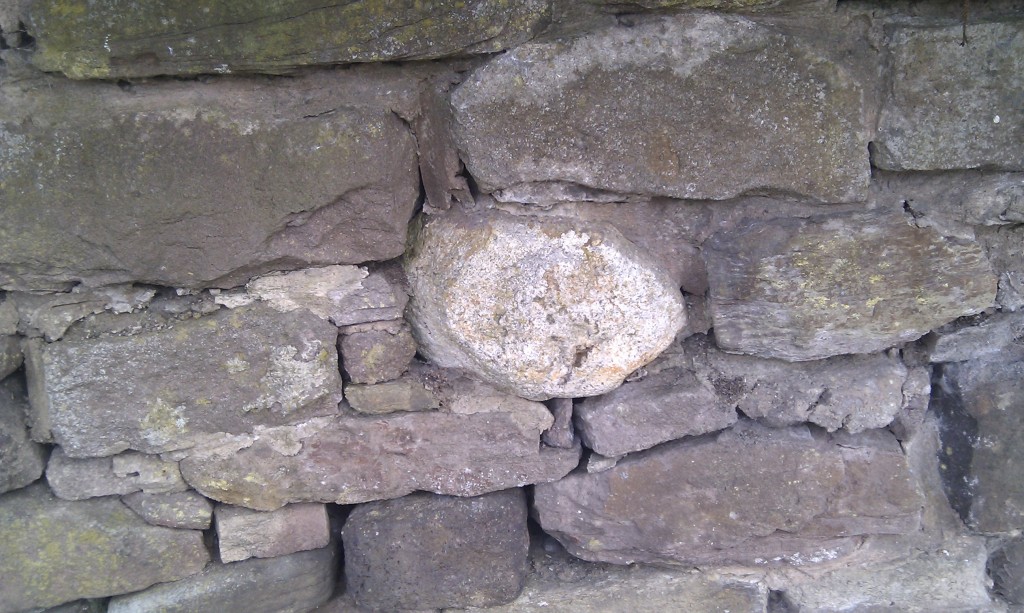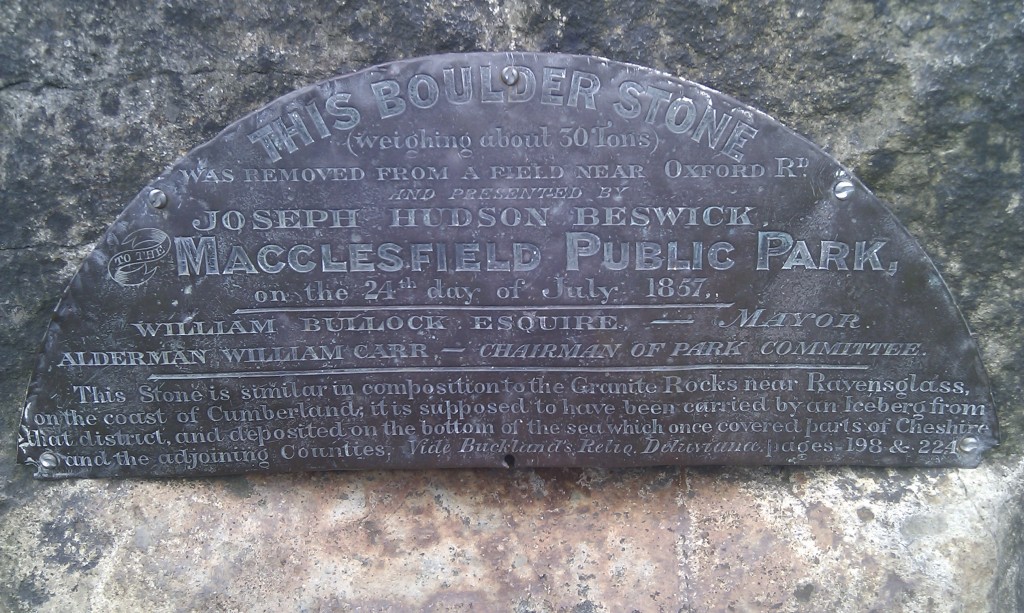I’ve recently spent a lot of time with my kids in the fabulous public parks of Macclesfield. An ex-mill town in the north of England, Macclesfield expanded greatly in the Nineteenth Century and the civic leaders at the time took care to build large green spaces into the town. In a nicely manicured lawn in West Park, there is a large stone, which is rather interesting.
It is a large boulder with rough edges, but a striated smooth top. It is of course a glacial erratic, that is a large block of rock, picked up in a glacier or ice sheet, moved a long way and then dumped somewhere else. It is, in the loosest sense, granite and to anyone familiar with English geology, comes from the Lake District. Smaller blocks from the Lake District are extremely common in the East Cheshire area, and are often seen ‘sticking out’ of dry-stone walls, where their rounded shape spoils the otherwise regular pattern.

A teenie-tiny glacial erratic incorporated into a typical Macclesfield stone wall. The rounded white-weathering block of Lake District igneous rock contrasts with regular bedded local stone
At the last Ice-Age maximum, Macclesfield was near the southern edge of the glaciated area, which covered pretty much all of the British Isles to the north. An ice-dome centred on the high ground of the Lake District swept down south over the Cheshire Plain. Just east of Macclesfield is the higher ground of the Peak District, that remained unglaciated.
The West Park boulder was found in 1857 and was moved a small way by a team of 8 horses into the 3 year old park where it was put on a plinth and a brass plaque attached.
The bottom section of the text says: “This Stone is similar in composition to the Granite Rocks near Ravenglass on the coast of Cumberland; it is supposed to have been carried by an Iceberg from that district and deposited on the bottom of the sea which once covered parts of Cheshire and the adjoining Counties. Vide Buckland’s Relio. Deluvianae, pages 198 & 224″.
William Buckland, was an interesting character and important figure in Nineteenth Century science. His 1823 book, referenced on the plaque, “Reliquiæ diluvianæ: or Observations on the organic remains contained in caves, fissures, and diluvial gravel, and on other geological phenomena, attesting the action of an universal deluge” was a best-seller and evidently a copy made it as far as Macclesfield. Following the plaque reference to page 199 shows that the reference to Ravenglass is a direct lift from Buckland’s book (rocks like this are found all over the Lake District, Ravenglass is only where Buckland happened to see them). Page 224 summarises his main argument, that blocks like this are evidence of a ‘universal deluge’, such as described in the bible, and that this block is a relict of the Biblical flood.
William Buckland is a great figure in Geology, because, like Darwin, he was one of the people who used careful observation to overturn the traditional idea that the Bible is a literal description of the Earth’s history. By 1836 he had changed his mind about the flood and by 1840 was in agreement with Louis Agassiz‘s theory that features such as erratics were the product of glacial processes.
So, by 1857, the theory expressed in Reliquae diluvianae had been rejected by its own author in favour of one we would agree with today. However nobody had told the good folk of Macclesfield. Or had they? The reference to an iceberg as the form of transport does not come from Buckland’s early book; Noah’s ark was not an ice-breaker, so where does the ice reference come from? It suggests to me that the text on the plaque is a form of compromise. The book and its idea of the block moving while Macclesfield was underwater is in there, but so is a reference to the more modern theory of ice being involved. The result is still wrong (an ice-sheet, not an iceberg was the form of transport) and it is not surprising that they started their description with the phrase “it is supposed to have been”, if they couldn’t agree amongst themselves.
So, next time you get access to most of human knowledge via your smart-phone, spare a thought for your ancestors. This plaque reminds us that only 150 years ago, in a town in one of the (then) most-developed and wealthiest countries on earth, the most definitive source of geological information available was a 30 year old book.



Pingback: From Erratics to an erratic | Earth Science Erratics
Pingback: Granite and green shoes (AW #42) | Metageologist
Pingback: A year of metageologising | Metageologist
Thank you Simon, very interesting,
Pingback: The edge of Cheshire. Part 2 – layers of landscape | Metageologist
This is very interesting indeed!
Pingback: Traces of glacial ice and water | Metageologist